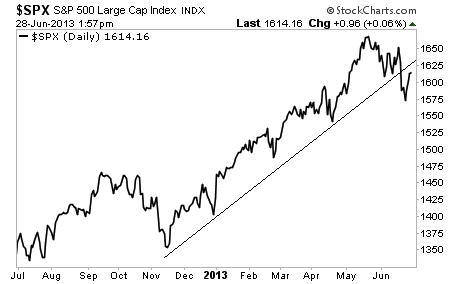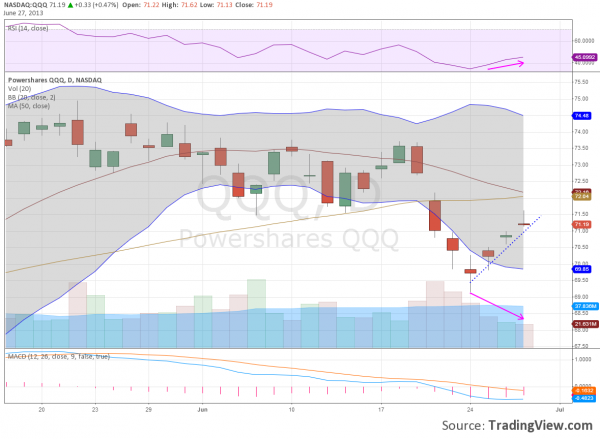by Tyler Durden
The first of three Fed speeches is out, and as expected, it contains nothing new save for the ongoing barage of stock market battering for daring to sell on last week's Bernanke warnings that the Fed's monthly flow is set to begin tapering in September. It continues to be as if the Fed is shocked to learn that nothing else matters in this "economy" and, of course, "market" than what the Fed will do and say.
Here is the highlight paragraph:
... it often doesn't make sense to try to explain a large movement in asset prices by looking for a correspondingly large change in expectations about economic fundamentals. So while we have seen very significant increases in long-term Treasury yields since the FOMC meeting, I think it is a mistake to infer from these movements that there must have been an equivalently big change in monetary policy fundamentals. Nothing we have said suggests a change in our reaction function for the path of the short-term policy rate, and my sense is that our sharpened guidance on the duration of the asset purchase program also leaves us close to where market expectations--as expressed, for example, in various surveys that we monitor--were beforehand.
And here is why futures are now sliding - nothing quite like a hypothetical assumption in a Fed governor speech:
Both in an effort to make reliable judgments about the state of the economy, as well as to reduce the possibility of an undesirable feedback loop, the best approach is for the Committee to be clear that in making a decision in, say, September, it will give primary weight to the large stock of news that has accumulated since the inception of the program and will not be unduly influenced by whatever data releases arrive in the few weeks before the meeting--as salient as these releases may appear to be to market participants. I should emphasize that this would not mean abandoning the premise that the program as a whole should be both data-dependent and forward looking.
Expect similar speeched from the other two Fed members due out later today.
Full speech:
Comments on Monetary Policy
Thank you very much. It's a pleasure for me to be here at the Council on Foreign Relations, and I look forward to our conversation. To get things going, I thought I would start with some brief remarks on the current state of play in monetary policy. As you know, at the Federal Open Market Committee (FOMC) meeting last week, we opted to keep our asset purchase program running at the rate of $85 billion per month. But there has been much discussion about recent changes in our communication, both in the formal FOMC statement, as well as in Chairman Bernanke's post-meeting press conference. I'd like to offer my take on these changes, as well as my thoughts on where we might go from here. But before doing so, let me note that I am speaking for myself, and that my views are not necessarily shared by my colleagues on the FOMC.
It's useful to start by discussing the initial design and conception of this round of asset purchases. Two features of the program are noteworthy. The first is its flow-based, state-contingent nature--the notion that we intend to continue with purchases until the outlook for the labor market has improved substantially in a context of price stability. The second is the fact that--in contrast to our forward guidance for the federal funds rate--we chose at the outset of the program not to articulate what "substantial improvement" means with a specific numerical threshold. So while the program is meant to be data-dependent, we did not spell out the nature of this data-dependence in a formulaic way.
To be clear, I think that this choice made a lot of sense, particularly at the outset of the program. Back in September it would have been hard to predict how long it might take to reach any fixed labor market milestone, and hence how large a balance sheet we would have accumulated along the way to that milestone. Given the uncertainty regarding the costs of an expanding balance sheet, it seemed prudent to preserve some flexibility. Of course, the flip side of this flexibility is that it entailed providing less- concrete information to market participants about our reaction function for asset purchases.
Where do we stand now, nine months into the program? With respect to the economic fundamentals, both the current state of the labor market, as well as the outlook, have improved since September 2012. Back then, the unemployment rate was 8.1percent and nonfarm payrolls were reported to have increased at a monthly rate of 97,000 over the prior six months; today, those figures are 7.6 percent and 194,000, respectively. Back then, FOMC participants were forecasting unemployment rates around 7-3/4 percent and 7 percent for year-end 2013 and 2014, respectively, in our Summary of Economic Projections; as of the June 2013 round, these forecasts have been revised down roughly 1/2 percentage point each. While it is difficult to determine precisely, I believe that our asset purchases since September have supported this improvement. For example, some of the brightest spots in recent months have been sectors that traditionally respond to monetary accommodation, such as housing and autos. Although asset purchases also bring with them various costs and risks--and I have been particularly concerned about risks relating to financial stability--thus far I would judge that they have passed the cost-benefit test.
However, this very progress has brought communications challenges to the fore, since the further down the road we get, the more information the market demands about the conditions that would lead us to reduce and eventually end our purchases. This imperative for clarity provides the backdrop against which our current messaging should be interpreted. In particular, I view Chairman Bernanke's remarks at his press conference--in which he suggested that if the economy progresses generally as we anticipate then the asset purchase program might be expected to wrap up when unemployment falls to the 7 percent range--as an effort to put more specificity around the heretofore less well-defined notion of "substantial progress."
It is important to stress that this added clarity is not a statement of unconditional optimism, nor does it represent a departure from the basic data-dependent philosophy of the asset purchase program. Rather, it involves a subtler change in how data-dependence is implemented--a greater willingness to spell out what the Committee is looking for, as opposed to a "we'll know it when we see it" approach. As time passes and we make progress toward our objectives, the balance of the tradeoff between flexibility and specificity in articulating these objectives shifts. It would have been difficult for the Committee to put forward a 7 percent unemployment goal when the current program started and unemployment was 8.1 percent; this would have involved a lot of uncertainty about the magnitude of asset purchases required to reach this goal. However, as we get closer to our goals, the balance sheet uncertainty becomes more manageable--at the same time that the market's demand for specificity goes up.
In addition to guidance about the ultimate completion of the program, market participants are also eager to know about the conditions that will govern interim adjustments to the pace of purchases. Here too, it makes sense for decisions to be data-dependent. However, a key point is that as we approach an FOMC meeting where an adjustment decision looms, it is appropriate to give relatively heavy weight to the accumulated stock of progress toward our labor market objective and to not be excessively sensitive to the sort of near-term momentum captured by, for example, the last payroll number that comes in just before the meeting.
In part, this principle just reflects sound statistical inference--one doesn't want to put too much weight on one or two noisy observations. But there is more to it than that. Not only do FOMC actions shape market expectations, but the converse is true as well: Market expectations influence FOMC actions. It is difficult for the Committee to take an action at any meeting that is wholly unanticipated because we don't want to create undue market volatility. However, when there is a two-way feedback between financial conditions and FOMC actions, an initial perception that noisy recent data play a central role in the policy process can become somewhat self-fulfilling and can itself be the cause of extraneous volatility in asset prices.
Thus both in an effort to make reliable judgments about the state of the economy, as well as to reduce the possibility of an undesirable feedback loop, the best approach is for the Committee to be clear that in making a decision in, say, September, it will give primary weight to the large stock of news that has accumulated since the inception of the program and will not be unduly influenced by whatever data releases arrive in the few weeks before the meeting--as salient as these releases may appear to be to market participants. I should emphasize that this would not mean abandoning the premise that the program as a whole should be both data-dependent and forward looking. Even if a data release from early September does not exert a strong influence on the decision to make an adjustment at the September meeting, that release will remain relevant for future decisions. If the news is bad, and it is confirmed by further bad news in October and November, this would suggest that the 7 percent unemployment goal is likely to be further away, and the remainder of the program would be extended accordingly.
In sum, I believe that effective communication for us at this stage involves the following key principles: (1) reaffirming the data-dependence of the asset purchase program, (2) giving more clarity on the type of data that will determine the endpoint of the program, as the Chairman did in his discussion of the unemployment goal, and (3) basing interim adjustments to the pace of purchases at any meeting primarily on the accumulated progress toward our goals and not overemphasizing the most recent momentum in the data.
I have been focusing thus far on our efforts to enhance communications about asset purchases. With respect to our guidance on the path of the federal funds rate, we have had explicit links to economic outcomes since last December, and we reaffirmed this guidance at our most recent meeting. Specifically, we continue to have a 6.5 percent unemployment threshold for beginning to consider a first increase in the federal funds rate. As we have emphasized, the threshold nature of this forward guidance embodies further flexibility to react to incoming data. If, for example, inflation readings continue to be on the soft side, we will have greater scope for keeping the funds rate at its effective lower bound even beyond the point when unemployment drops below 6.5percent.
Of course, there are limits to how much even good communication can do to limit market volatility, especially at times like these. At best, we can help market participants to understand how we will make decisions about the policy fundamentals that the FOMC controls--the path of future short-term policy rates and the total stock of long-term securities that we ultimately plan to accumulate via our asset purchases. Yet as research has repeatedly demonstrated, these sorts of fundamentals only explain a small part of the variation in the prices of assets such as equities, long-term Treasury securities, and corporate bonds. The bulk of the variation comes from what finance academics call "changes in discount rates," which is a fancy way of saying the non-fundamental stuff that we don't understand very well--and which can include changes in either investor sentiment or risk aversion, price movements due to forced selling by either levered investors or convexity hedgers, and a variety of other effects that fall under the broad heading of internal market dynamics.
This observation reminds us that it often doesn't make sense to try to explain a large movement in asset prices by looking for a correspondingly large change in expectations about economic fundamentals. So while we have seen very significant increases in long-term Treasury yields since the FOMC meeting, I think it is a mistake to infer from these movements that there must have been an equivalently big change in monetary policy fundamentals. Nothing we have said suggests a change in our reaction function for the path of the short-term policy rate, and my sense is that our sharpened guidance on the duration of the asset purchase program also leaves us close to where market expectations--as expressed, for example, in various surveys that we monitor--were beforehand.
I don't in any way mean to say that the large market movements that we have seen in the past couple of weeks are inconsequential or can be dismissed as mere noise. To the contrary, they potentially have much to teach us about the dynamics of financial markets and how these dynamics are influenced by changes in our communications strategy. My only point is that consumers and businesses who look to asset prices for clues about the future stance of monetary policy should take care not to over-interpret these movements. We have attempted in recent weeks to provide more clarity about the nature of our policy reaction function, but I view the fundamentals of our underlying policy stance as broadly unchanged.
Thank you. I look forward to your questions
See the original article >>


























